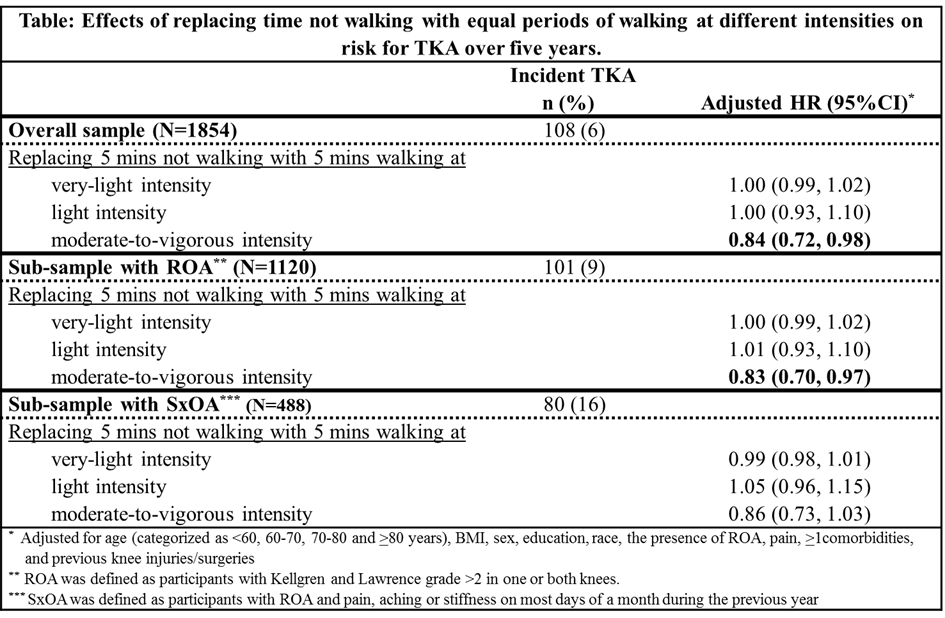Session Information
Session Type: ACR Poster Session B
Session Time: 9:00AM-11:00AM
Background/Purpose: There is contradicting evidence whether walking more is associated with structural worsening and total knee arthroplasty (TKA). One reason for inconsistent findings is that walking can occur at different intensities. However, little is known about the association of walking intensity with the risk of TKA. The purpose of this study was to examine the extent to which walking intensity is associated with the risk of TKA over five years in adults with or at high risk of knee OA.
Methods: Using data from the Osteoarthritis Initiative (OAI), we included participants who did not have TKA at or before the 48-month follow-up visit, which we considered our study baseline. Time spent in different walking intensities was quantified by step cadence recorded by an accelerometer (Actigraph GT1M). We defined <1 step/min as non-walking, 1-49 steps/min as very-light, 50-100 steps/min as light, and >100 steps/min as moderate-to-vigorous intensities of walking. Time to TKA was quantified in months from the baseline visit date to TKA date if received in the subsequent five years, i.e., until the 108-month OAI visit. Participants without TKA at the 108-month OAI visit or lost to follow-up were censored. We examined effects of replacing time not walking with walking at very-light, light, or moderate-to-vigorous intensities with the risk of TKA over five years using isotemporal substitution within a Cox proportional hazard model. Specifically, we calculated hazard ratios (HR) and 95% confidence interval (CI) adjusted for potential confounders. We repeated analyses restricting our sample to participants with radiographic (ROA) and symptomatic (SxOA) knee OA (see Table).
Results: Of the 1854 participants without TKA at baseline and who wore the accelerometer for ≥ 4 days ([mean ± sd] age: 65.0 ± 9.1 years, BMI: 28.4 ± 4.8 kg/m2, 55% female), 108 (6%) participants received a TKA over five years. Replacing 5 minutes of non-walking time with 5 min of walking at moderate-to-vigorous intensity reduced the risk of TKA by 16% (HR 0.84, 95%CI [0.72, 0.98]). There was no effect for very-light and light intensity. We found similar results for ROA and SxOA only samples (see Table).
Conclusion: Replacing time not walking with walking at moderate-to-vigorous intensity was associated with not more but less risk of TKA over five years. Our findings suggest that small changes in walking behavior could delay the need for TKA in people with or at high risk of knee OA.
To cite this abstract in AMA style:
Master H, Thoma L, Christiansen M, Mathews D, Macri E, Ziegler M, Stefanik JJ, White D. Friend or Foe: Does Walking at Higher Intensities Increase or Decrease the Risk of Total Knee Arthroplasty over Five Years? [abstract]. Arthritis Rheumatol. 2018; 70 (suppl 9). https://acrabstracts.org/abstract/friend-or-foe-does-walking-at-higher-intensities-increase-or-decrease-the-risk-of-total-knee-arthroplasty-over-five-years/. Accessed .« Back to 2018 ACR/ARHP Annual Meeting
ACR Meeting Abstracts - https://acrabstracts.org/abstract/friend-or-foe-does-walking-at-higher-intensities-increase-or-decrease-the-risk-of-total-knee-arthroplasty-over-five-years/

